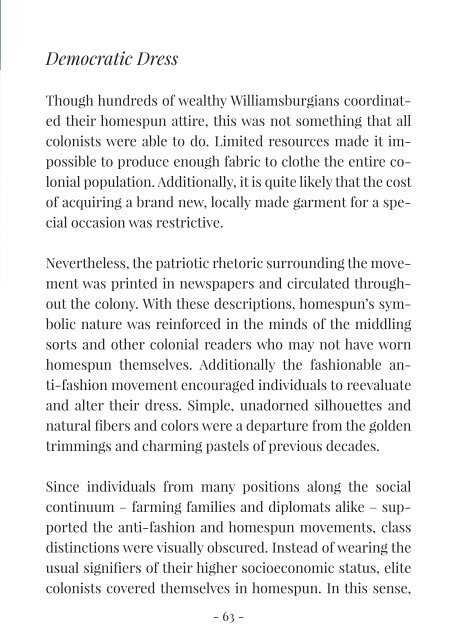The Fleece of Their Flock: Homespun & the American Identity
This interdisciplinary thesis project was researched, written, and designed by Jessica Vodnik and submitted in fulfillment of the Honors Senior Capstone requirement for the DePaul University Honors Program. Please do not copy, reproduce, or distribute without permission. Dr. Amy Tyson, Director, American Studies Dr. John Burton, Second Reader, History Undergraduate Honors Senior Thesis DePaul University, Chicago, IL May 10, 2015
This interdisciplinary thesis project was researched, written, and designed by Jessica Vodnik and submitted in fulfillment of the Honors Senior Capstone requirement for the DePaul University Honors Program. Please do not copy, reproduce, or distribute without permission.
Dr. Amy Tyson, Director, American Studies
Dr. John Burton, Second Reader, History
Undergraduate Honors Senior Thesis
DePaul University, Chicago, IL
May 10, 2015
You also want an ePaper? Increase the reach of your titles
YUMPU automatically turns print PDFs into web optimized ePapers that Google loves.
Democratic Dress<br />
Though hundreds <strong>of</strong> wealthy Williamsburgians coordinated<br />
<strong>the</strong>ir homespun attire, this was not something that all<br />
colonists were able to do. Limited resources made it impossible<br />
to produce enough fabric to clo<strong>the</strong> <strong>the</strong> entire colonial<br />
population. Additionally, it is quite likely that <strong>the</strong> cost<br />
<strong>of</strong> acquiring a brand new, locally made garment for a special<br />
occasion was restrictive.<br />
Never<strong>the</strong>less, <strong>the</strong> patriotic rhetoric surrounding <strong>the</strong> movement<br />
was printed in newspapers and circulated throughout<br />
<strong>the</strong> colony. With <strong>the</strong>se descriptions, homespun’s symbolic<br />
nature was reinforced in <strong>the</strong> minds <strong>of</strong> <strong>the</strong> middling<br />
sorts and o<strong>the</strong>r colonial readers who may not have worn<br />
homespun <strong>the</strong>mselves. Additionally <strong>the</strong> fashionable anti-fashion<br />
movement encouraged individuals to reevaluate<br />
and alter <strong>the</strong>ir dress. Simple, unadorned silhouettes and<br />
natural fibers and colors were a departure from <strong>the</strong> golden<br />
trimmings and charming pastels <strong>of</strong> previous decades.<br />
Since individuals from many positions along <strong>the</strong> social<br />
continuum – farming families and diplomats alike – supported<br />
<strong>the</strong> anti-fashion and homespun movements, class<br />
distinctions were visually obscured. Instead <strong>of</strong> wearing <strong>the</strong><br />
usual signifiers <strong>of</strong> <strong>the</strong>ir higher socioeconomic status, elite<br />
colonists covered <strong>the</strong>mselves in homespun. In this sense,<br />
- 63 -


